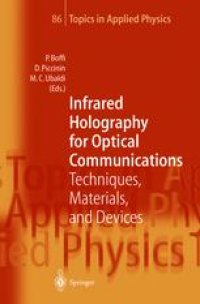
Ebook: Infrared Holography for Optical Communications: Techniques, Materials, and Devices
- Tags: Laser Technology and Physics Photonics, Applied Optics Optoelectronics Optical Devices, Communications Engineering Networks, Polymer Sciences
- Series: Topics in Applied Physics 86
- Year: 2003
- Publisher: Springer-Verlag Berlin Heidelberg
- Edition: 1
- Language: English
- pdf
The aim of this book is to exploit the advantages of holographic technology, namely the high storage capacity and fast access times, in order to implement optical devices for infrared fiber communication applications. The covered methods range from two-lambda to gated recording techniques, all of which can be applied to a variety of materials such as photorefractive crystals and photopolymers. Both techniques and materials are strictly related to the practical realization of signal processing devices, showing their feasibility and discussing their role in a realistic telecoms network. Research scientists, engineers and graduate students will benefit equally from the combined coverage of technological features, optical communications components, and network perspectives.
The aim of this book is to exploit the advantages of holographic technology, namely the high storage capacity and fast access times, in order to implement optical devices for infrared fiber communication applications. The covered methods range from two-lambda to gated recording techniques, all of which can be applied to a variety of materials such as photorefractive crystals and photopolymers. Both techniques and materials are strictly related to the practical realization of signal processing devices, showing their feasibility and discussing their role in a realistic telecoms network. Research scientists, engineers and graduate students will benefit equally from the combined coverage of technological features, optical communications components, and network perspectives.
The aim of this book is to exploit the advantages of holographic technology, namely the high storage capacity and fast access times, in order to implement optical devices for infrared fiber communication applications. The covered methods range from two-lambda to gated recording techniques, all of which can be applied to a variety of materials such as photorefractive crystals and photopolymers. Both techniques and materials are strictly related to the practical realization of signal processing devices, showing their feasibility and discussing their role in a realistic telecoms network. Research scientists, engineers and graduate students will benefit equally from the combined coverage of technological features, optical communications components, and network perspectives.
Content:
Front Matter....Pages I-XI
Review of Optical Data Storage....Pages 1-22
Two-Step Processes and IR Recording in Photorefractive Crystals....Pages 23-40
Gated Optical Recording for Nonvolatile Holography in Photorefractive Materials....Pages 41-58
Photorefractive Copper-Doped LiNbO3 Waveguides for Holography Fabricated by a Combined Technique of Ion Exchange and Ion Implantation....Pages 59-75
Two-Photon Optical Storage in Photorefractive Polymers in the Near-Infrared Spectral Range....Pages 75-91
Long-Lifetime Photorefractive Holographic Devices via Thermal Fixing Methods....Pages 91-112
Holographic Reflection Filters in Photorefractive LiNbO3 Channel Waveguides....Pages 113-132
Optical Lambda-Switching at Telecom Wavelengths Based on Electroholography....Pages 133-161
1550 nm Volume Holographic Devices for Optical Communication Networks....Pages 162-184
Back Matter....Pages 179-181
The aim of this book is to exploit the advantages of holographic technology, namely the high storage capacity and fast access times, in order to implement optical devices for infrared fiber communication applications. The covered methods range from two-lambda to gated recording techniques, all of which can be applied to a variety of materials such as photorefractive crystals and photopolymers. Both techniques and materials are strictly related to the practical realization of signal processing devices, showing their feasibility and discussing their role in a realistic telecoms network. Research scientists, engineers and graduate students will benefit equally from the combined coverage of technological features, optical communications components, and network perspectives.
Content:
Front Matter....Pages I-XI
Review of Optical Data Storage....Pages 1-22
Two-Step Processes and IR Recording in Photorefractive Crystals....Pages 23-40
Gated Optical Recording for Nonvolatile Holography in Photorefractive Materials....Pages 41-58
Photorefractive Copper-Doped LiNbO3 Waveguides for Holography Fabricated by a Combined Technique of Ion Exchange and Ion Implantation....Pages 59-75
Two-Photon Optical Storage in Photorefractive Polymers in the Near-Infrared Spectral Range....Pages 75-91
Long-Lifetime Photorefractive Holographic Devices via Thermal Fixing Methods....Pages 91-112
Holographic Reflection Filters in Photorefractive LiNbO3 Channel Waveguides....Pages 113-132
Optical Lambda-Switching at Telecom Wavelengths Based on Electroholography....Pages 133-161
1550 nm Volume Holographic Devices for Optical Communication Networks....Pages 162-184
Back Matter....Pages 179-181
....